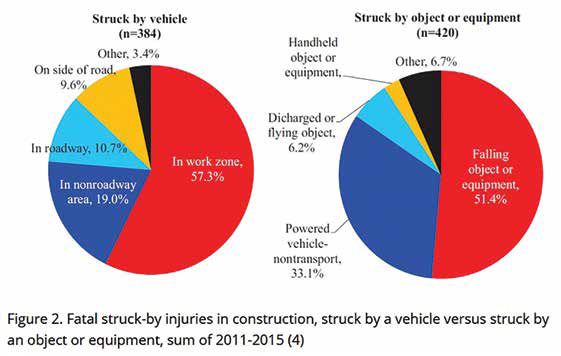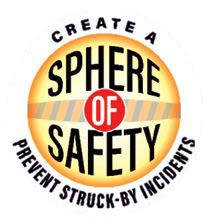The following guide is compiled from publications by OSHA, the Occupational Safety and Health Administration, and from the “NIOSH Science Blog” on the Centers for Disease Control and Prevention (CDC) website. The data were researched by the National Institute for Occupational Safety and Health (NIOSH).
Struck-by injuries are the leading cause of nonfatal injuries and the second most common cause of fatalities among construction workers, costing over $1.7 billion in workers compensation costs in 2016. These injuries occur when a worker is struck by a moving vehicle, equipment, or by a falling or flying object.
For construction workers, the risk of nonfatal struck-by injuries is twice the risk of all other industries combined, and construction workers have the highest number of fatal struck-by injuries compared to any other industry. Employers and employees can work together to raise awareness and prevent struck-by injuries.
Which struck-by events most commonly cause non-fatal injury?
Compared to all other industries, construction workers have the highest rate of nonfatal struckby injuries at 2.7 per 10,000 Full-Time Equivalent (FTE) workers. The most common sources of nonfatal struck-by injuries involved solid building materials, powered and non-powered hand tools, and scrap/waste/debris. The rate of nonfatal struckby injuries is highest among helpers, sheet metal workers, heating and air conditioning mechanics, and ironworkers (see Figure 1). Most nonfatal struck-by injuries (96%) are caused by falling or flying objects, or equipment. The most common events leading to a non-fatal injury include being struck by handheld objects or equipment (36%), falling objects or equipment (29%), and discharged or flying objects (14%).
Which struck-by events most commonly cause fatal injury?
Fatal struck-by injuries occur when a motor vehicle intrudes into a work zone or when construction vehicles and heavy equipment operate within a work zone. About half of fatal struck-by injuries were caused by a pedestrian being struck by a vehicle (384 fatalities or 48%). In comparison to non-fatal injuries, about half of the non-work zone fatalities involve a falling object or equipment (51%) and 33% involve a powered vehicle not in transport (see Figure 2).
What can employers do to prevent struck-by injuries?
When operating heavy equipment (cranes, excavators, etc.)
Employers must:
▪ Determine whether the ground is sufficiently level and firm to support the anticipated weight of hoisting equipment and associated loads;
▪ Assess hazards within the work zone that would affect the safe operation of hoisting equipment such as, power lines and objects or personnel that would be within the swing radius of the hoisting equipment;
▪ Erect barriers to mark the area covered by the rotating superstructure to warn workers of the danger zone;
▪ Ensure that the equipment is in safe operating condition via required inspections;
▪ Comply with all manufacturer procedures regarding proper operational functions of equipment, including its use with attachments;
▪ Ensure safe attachment of rigging devices such as shackles, hooks, eyebolts, spreader beams and slings, wedge socket and wire rope clips;
▪ Provide seat belts when required;
▪ Ensure roadways and grades are maintained to accommodate the safe movement of equipment and vehicles;
▪ Ensure all earth-moving and compacting equipment with obstructed view does not operate in reverse gear unless the equipment has a reverse signal alarm or a worker has been designated to signal when it is safe.
When operating motor vehicles
The employer is required to do the following:
▪ Conduct a hazard assessment of the worksite using the job-site coordinator (supervisor or foreman) who should:
Make a thorough assessment of potential worksite safety hazards;
Plan for work being conducted in close proximity of a public road or highway and for the safe handling of intermittent roadway traffic stoppages, such as a truck entering a roadway; and
Plan the entry and exit to and from the worksite to reduce exposure to traffic
Post construction areas with legible traffic signs at points of hazard;
▪ Erect barricades that conform to the MUTCD;
▪ Place necessary warning signs along the road;
▪ All workers on site should have a safety and operations orientation.
General requirements for protecting workers. Employers must ensure:
▪ All hand tools are maintained in good condition;
▪ The use of unsafe hand tools is not permitted (i.e., no sprung jaws on wrenches, no mushroomed heads, no splinters or cracks in wooden handles, no loose parts / heads of tools);
▪ Saws are equipped with guards and have a constant pressure switch that will shut off the power when the pressure is released;
▪ Safety guards are on all abrasive wheel bench and stand grinders;
▪ Only trained workers are allowed to operate powder- actuated tools;
▪ All powder-actuated tools are tested daily before use and all defects discovered before or during use are corrected;
▪ Powder-actuated tools are not loaded until immediately before use and loaded tools are not left unattended;
▪ Compressed air used for cleaning purposes is reduced to less than 30 pounds per square inch (psi) and provide effective chip guarding and PPE;
▪ All materials stored in tiers are secured to prevent sliding, falling, or collapsing;
▪ Toeboards are erected along the edge of overhead walking/working surfaces.
Provide personal protective equipment (PPE)
Employers must:
▪ Pay for PPE as required by OSHA;
▪ Provide and require the use of appropriate PPE in all operations where there is an exposure to hazardous conditions;
▪ Ensure adequacy of PPE including proper maintenance and sanitation;
▪ Provide head protection (e.g. hard hats, helmets) whenever there is possible danger of head injuries from impact, flying or falling objects;
▪ Provide eye and face protection when machines or operations present eye or face injury;
▪ Provide workers involved in welding operations with filter lenses or plates of proper shade number;
▪ Ensure eye, face and head protective equipment meets ANSI requirements.
Training
▪ Train workers in the work zone to recognize hazards associated with the use of the equipment and any related duties that they are assigned to perform;
▪ Ensure crane operators are qualified or certified according to OSHA standards;
▪ Ensure signal person meets qualification requirement according to OSHA standards;
▪ Instruct workers in the recognition and avoidance of unsafe conditions and the regulations applicable to his/her work environment to control or eliminate any hazards or other exposure to illness or injury;
▪ Ensure that qualified operators and riggers have been trained on rigging safety.
The Occupational Safety and Health Administration Safety (OSHA) defines a safety stand-down presentation as a brief work stoppage for the purpose of bringing employees together to discuss workplace safety. A safety stand-down meeting takes time out of the work day to address pressing safety issues. The 2nd annual National Stand-Down to Prevent Struck-by Incidents took place on April 26, 2021. A date for 2022 has not yet been announced.
Republished from Marine Construction Magazine Issue V, 2022











